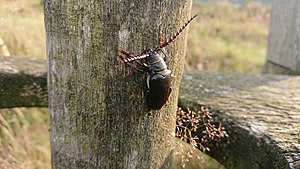| dbo:abstract
|
- Prionus laticollis es una especie de escarabajo longicornio del género Prionus, tribu Prionini. Fue descrita científicamente por Drury en 1773. Se distribuye por Canadá y Estados Unidos. Mide 20-50 milímetros de longitud. El período de vuelo ocurre en los meses de junio a octubre. (es)
- Prionus laticollis adalah spesies kumbang tanduk panjang yang tergolong famili Cerambycidae. Spesies ini juga merupakan bagian dari genus Prionus, ordo Coleoptera, kelas Insecta, filum Arthropoda, dan kingdom Animalia. Larva kumbang ini biasanya mengebor ke dalam kayu dan dapat menyebabkan kerusakan pada batang kayu hidup atau kayu yang telah ditebang. (in)
- Prionus laticollis, also known as the broad-necked root borer, is a root-boring longhorn beetle described by Drury in 1773. It is widespread throughout eastern North America: its range covers a vast swath from Quebec in the northeast to Arkansas in the southwest. The larvae damage trees and other plants by feeding on their roots. They are mostly active during dusk and at night. They are good burrowers and hide at the base of oak trees and other food sources. The female is larger than the male, with an ovipositor used to deposit eggs. When the female is laying eggs, she "shivers" and eggs are laid through the ovipositor, positioned down into the soil or under litter, usually in groups of threes and twos, but sometimes ones or fours. After the eggs are laid, the female moves her ovipositor up and down to fill the hole she created. When freshly laid, the eggs are pure white, glistening with moisture, but, after a while, they usually change to a deep yellow. Within a few days, the deep yellow eggs turn to a light washed pink. As the larvae develop inside, the eggs turn ivory in color. The eggs are the size of small grains of rice. When the larvae are hatching, they chew through one of the elongated, pointed sides of the egg. The larvae's heads are adapted for digging into the soil, and they have strong black mandibles for chewing roots. Larvae tunnel downward to feed on the living roots of a variety of trees and shrubs. At first, they may feed on bark, but then proceed to hollow out small roots. They often feed on dead wood, with a preference for soft food.Pupation occurs in spring, about 10 cm under the ground. During pupation parts of the digestive tract degenerate. The life cycle is probably three years. The male flies more often than the female. Males are also attracted to lights. (en)
- Prionus laticollis is een keversoort uit de familie van de boktorren (Cerambycidae). De wetenschappelijke naam van de soort werd voor het eerst geldig gepubliceerd in 1773 door Drury. (nl)
- Prionus laticollis är en skalbaggsart som först beskrevs av Dru Drury 1773. Prionus laticollis ingår i släktet Prionus och familjen långhorningar. Inga underarter finns listade i Catalogue of Life. (sv)
|
| dbo:thumbnail
| |
| dbo:wikiPageID
| |
| dbo:wikiPageLength
|
- 5013 (xsd:nonNegativeInteger)
|
| dbo:wikiPageRevisionID
| |
| dbo:wikiPageWikiLink
| |
| dbp:authority
| |
| dbp:genus
| |
| dbp:species
| |
| dbp:synonyms
|
- - Prionus brevicornis Fabricius 1801
- Prionus densus Casey 1924
- Prionus frosti Casey 1924
- Prionus kempi Casey 1912
- Prionus nigrescens Casey 1924
- Prionus parvus Casey 1912 (en)
|
| dbp:wikiPageUsesTemplate
| |
| dct:subject
| |
| rdfs:comment
|
- Prionus laticollis es una especie de escarabajo longicornio del género Prionus, tribu Prionini. Fue descrita científicamente por Drury en 1773. Se distribuye por Canadá y Estados Unidos. Mide 20-50 milímetros de longitud. El período de vuelo ocurre en los meses de junio a octubre. (es)
- Prionus laticollis adalah spesies kumbang tanduk panjang yang tergolong famili Cerambycidae. Spesies ini juga merupakan bagian dari genus Prionus, ordo Coleoptera, kelas Insecta, filum Arthropoda, dan kingdom Animalia. Larva kumbang ini biasanya mengebor ke dalam kayu dan dapat menyebabkan kerusakan pada batang kayu hidup atau kayu yang telah ditebang. (in)
- Prionus laticollis is een keversoort uit de familie van de boktorren (Cerambycidae). De wetenschappelijke naam van de soort werd voor het eerst geldig gepubliceerd in 1773 door Drury. (nl)
- Prionus laticollis är en skalbaggsart som först beskrevs av Dru Drury 1773. Prionus laticollis ingår i släktet Prionus och familjen långhorningar. Inga underarter finns listade i Catalogue of Life. (sv)
- Prionus laticollis, also known as the broad-necked root borer, is a root-boring longhorn beetle described by Drury in 1773. It is widespread throughout eastern North America: its range covers a vast swath from Quebec in the northeast to Arkansas in the southwest. The larvae damage trees and other plants by feeding on their roots. They are mostly active during dusk and at night. They are good burrowers and hide at the base of oak trees and other food sources. The female is larger than the male, with an ovipositor used to deposit eggs. When the female is laying eggs, she "shivers" and eggs are laid through the ovipositor, positioned down into the soil or under litter, usually in groups of threes and twos, but sometimes ones or fours. After the eggs are laid, the female moves her ovipositor u (en)
|
| rdfs:label
|
- Prionus laticollis (es)
- Prionus laticollis (in)
- Prionus laticollis (nl)
- Prionus laticollis (en)
- Prionus laticollis (sv)
|
| owl:sameAs
| |
| prov:wasDerivedFrom
| |
| foaf:depiction
| |
| foaf:isPrimaryTopicOf
| |
| is dbo:wikiPageWikiLink
of | |
| is foaf:primaryTopic
of | |




